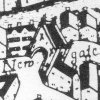Bristol Bridge
Bristol Bridge gave life to the city. For centuries its great bridge was the only crossing of the Avon for miles around. As Bristol spread to the southern bank of the river, the bridge joined the two halves of the city. So a Georgian bridge toll caused outrage and led to Bristol's bloodiest riot.

This view of Bristol Bridge from Welsh Back around 1750 shows the medieval bridge lined with tall Tudor houses, jettied out over the river. (Bristol Central Library)
Towns and cities often grow up around the lowest crossing point of major rivers. There traders can take advantage both of road and river traffic. Bristol is a case in point. Now it has many bridges, but Bristol Bridge was the first. This crucial crossing gave Bristol its Anglo-Saxon name - Brycgstow (bridge-place).
The Saxon bridge was probably timber-built. That would be good enough for light traffic, but as bustling Bristol became a major market and port, one can picture the bridge groaning under heavily laden carts and pack animals. No wonder that in the 1240s Bristol followed London in replacing its bridge in stone.
The impressive stone bridge across the Thames had been finished around 1200. Bristol merchants trading with the capital would have seen its advantages. A stone bridge was less vulnerable to fire and flood. And it could more easily support superstructures. What a tempting thought! Travellers from miles around were funnelled across major crossing points. A shop actually on a bridge could flash its goods before a constant stream of passers-by.
Like London Bridge, Bristol Bridge was rapidly lined with shops. It became one of the busiest commercial centres of the city. Traders lived above the shop and the houses on the bridge rose higher and higher over the centuries. They were timber-built and jettied out over the river and road to enlarge their floor space.

The Chapel of St Mary above the gate on Bristol Bridge
A stone bridge could also be fortified. Rivers often formed part of town defenses, so it made sense to guard the river crossing with a strong gateway. London, Bath and Bristol all once had bridge gates. In fact Bristol managed to combine a gate and a chapel in one massive structure.
Medieval bridges often had a chapel for divine protection, but Bristol's was astonishingly ambitious. The Chapel of the Assumption of the Blessed Virgin Mary was 75 feet by 21 feet. It stretched right across the centre of the bridge and out beyond it on either side, supported on extended piers. There was even a bell-tower. At street level was a crypt used by the Council for meetings. On the next floor was the chapel, which ran over a tunnel-like gateway with gates at either end. This magnificent structure was finished in 1361. It was closed at the Reformation along with other bridge chapels, which were seen as superstious. The building was converted to other purposes until finally taken down.
By the mid-1700s the houses on the bridge were under threat too. They were seen as an impediment to traffic. The roads were increasingly thronged with horses and carriages. London Bridge was cleared of houses and there was pressure for Bristol to follow suit. That would mean buying up some thirty houses, so the Council took years to steel itself to the purpose. It was prodded into action by citizens. One even commissioned local architect James Bridges to design a new bridge.

Bristol Bridge in 1823 by Hugh O'Neill. The classical design of the Georgian bridge was based on that of Westminster Bridge. It had toll houses at either end. (Bristol Museum and Art Gallery).
But how could it be paid for? Scarcely anyone could agree on ways and means, and there was just as much argument over what kind of bridge to build. Even after the Council obtained an Act of Parliament in 1760 to rebuild and enlarge the bridge, the disputes went on. Poor James Bridges suffered constant attacks on his competence by rival architects. In the end he despaired of Bristol and sailed for the West Indies. Ironically his design was carried out in the end. In 1768 the new bridge was opened.
That was not the end of its troubles. The Act had permitted the Bridge Trustees to pay for the bridge partly by a toll. That was deeply unpopular. What made matters worse was the Trustees' refusal to fully reveal their accounts. The toll-gathering went on and on. The Bridge Trustees said at one point that they had raised enough to clear the bridge debt and the toll would end in September 1793. But then when the due date came around they reneged on that promise.
It was folly. Bristol citizens first burnt the toll-gates and then the contents of the toll-houses. The Council responded by ordering the Militia to fire on the crowd. Eleven died and 52 were wounded. As the news spread, a wave of shock ran through the city. The events of this day were to live long in Bristol's memory. They did much to foment the clamour for reform of the Corporation.
The Georgian bridge that caused so much heart-ache and bloodshed is still there, but hidden beneath the broader roadway that was added in Victorian times.
Further reading: Barb Drummond, Death and the Bridge (2005).

























